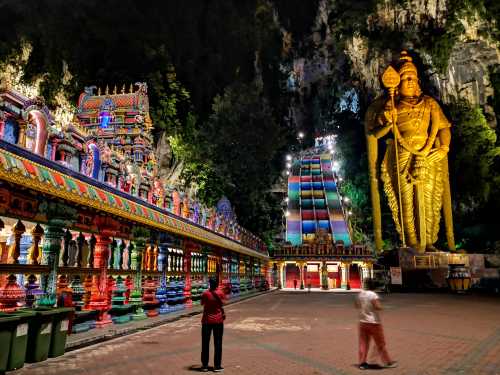App
Customer Support
Find Bookings
Popular Trip Moments
🦚 Batu Caves, Kuala Lumpur — A Summer Getaway Full of Adventure & Culture 🦚 | 🌈✨ Batu Caves – Where culture meets color and nature | The Fusion of Natural Wonders and Hindu Beliefs | Stairway to Wonder: Discover the Magic of Batu Caves! | Sightseeing Without Suffering: Batu Caves From Below | KL Trip Highlight: Batu Caves, Without the Muscle Cramps | 3 fantastic days in KL | Our Ascent to the Sacred Batu Caves | 🌆 Kuala Lumpur – A Vibrant Fusion of Cultures and Skylines 🇲🇾 | Malaysia Attractions-Batu Caves | Batu Caves | 【Kuala Lumpur】Batu Caves | “Batu Caves: A Sacred Journey Just Outside Kuala Lumpur”🕌 | Batu Caves | Colorful Climb at Batu Caves 🌈⛰️🛕 | Batu Caves – Climbing Colors, Culture & Curious Monkeys | 1-2h direct flights, visa-free and safe, three countries! | Kuala Lumpur Day Trip Itinerary | Malaysia🇲🇾Kuala Lumpur 1-day sightseeing plan | Batu caveee | Mystical and colorful power spot! Exploring Malaysia's Batu Caves | “Where Nature Meets Devotion – Batu Caves” | 🇲🇾 Kuala Lumpur. Part 3: A city that doesn’t try to impress — and that’s exactly its strength 🌆 | Malaysia's Batu Caves: A Sacred Hindu Site | Batu Caves is filled with adorable monkeys. | Batu Caves: A Sacred Stairway to the Sky | 🇲🇾 Kuala Lumpur – Part 2: A City That Makes You Stay Longer Than Planned 🏙️⏳🌴 | Hidden Gems Spot in Kuala Lumpur | Batu Caves: a hidden (not so hidden now) gem in Kuala Lumpur | Tour Kuala Lumpur: Batu Caves
Recommended Attractions at Popular Destinations
Attraction near Bangkok | Attraction near Manila | Attraction near Tokyo | Attraction near Taipei | Attraction near Hong Kong | Attraction near Seoul | Attraction near Kuala Lumpur | Attraction near Los Angeles | Attraction near Shanghai | Attraction near New York | Attraction near Shenzhen | Attraction near Osaka | Attraction near Singapore | Attraction near London | Attraction near Guangzhou | Attraction near San Francisco | Attraction near Beijing | Attraction near Macau | Attraction near Bali | Attraction near Jakarta | Attraction near Paris | Attraction near Ho Chi Minh City | Attraction near Istanbul | Attraction near Phuket | Attraction near Chicago | Attraction near Seattle | Attraction near Toronto | Attraction near Orlando | Attraction near Cebu | Attraction near Chiang Mai
Popular Restaurants in Batu Caves
Silver Spoon Kitchen | Code: Black Espresso | Restoran Lulu 126 Paradise | Malaya Steamboat Buffet | Hang Wan Restaurant | Serangor Culture Cove | Restoran Tang Dynasty | K'Chiangmai Ikan Bakar | Shiraz Wine and Cafe | Restoran Rani Pure Vegetarian & Jain Food | Amutha Restaurant | MyRail Coffee | Bamboos Thai Cafe | Coca Seafood Restaurant | Restoran Coca Seafood | Uncle Lim's Kitchen KLIA2 | Restoran Fong Kee | Selayang Tokyo Restaurant | Dhivya's Cafe | Songkhla Thai Seafood Restaurant | Maggi Ketam Bistro | Fans of secret recipe | Food Bowl Coffee Shop | Noooodles | Blockcafe | Restoran Ark | The Rack Boutique & Cafe | Restaurant Ikan Patin Che Ta | Thai Noodles at Restaurant Lucky Best | IPO Food Room | Surasa Ventures
Popular Ranked Lists
Popular Best Things to Do in Shaoyang | Popular Best Things to Do in Heze | Popular Premium Hotels in Kargicak Mahallesi | Popular Must-Visit Restaurants in Phuket | Top 5 Best Things to Do in Luzhou | Popular Must-Visit Restaurants in Rome | Popular Best Things to Do in Guang'an | Popular Premium Hotels in Sin el Fil | Popular Premium Hotels in Memphis | Popular Must-Visit Restaurants in George Town | Popular Must-Visit Restaurants in Bali | Popular Luxury Hotels Near Oakland | Popular Premium Hotels in Warnemunde | Popular Must-Visit Restaurants in New York | Popular Luxury Hotels Near Mannheim | Popular Premium Hotels in Hinderwell | Popular Must-Visit Restaurants in Athens | Top 8 Best Things to Do in Baishan | Popular Premium Hotels in Buenavista del Norte | Top 5 Best Things to Do in Huaihua | Popular Must-Visit Restaurants in Hanoi | Popular Luxury Hotels Near Kempten | Popular Luxury Hotels Near Schaumburg | Popular Premium Hotels in Goyang-si | Popular Best Things to Do in Wuzhong | Popular Best Things to Do in Daqing | Popular Luxury Hotels Near Netanya | Popular Best Things to Do in Luanping | Popular Luxury Hotels Near Lampang | Popular Must-Visit Restaurants in Auckland
Payment Methods
Our Partners
Copyright © 2025 Trip.com Travel Singapore Pte. Ltd. All rights reserved
Site Operator: Trip.com Travel Singapore Pte. Ltd.
Site Operator: Trip.com Travel Singapore Pte. Ltd.































